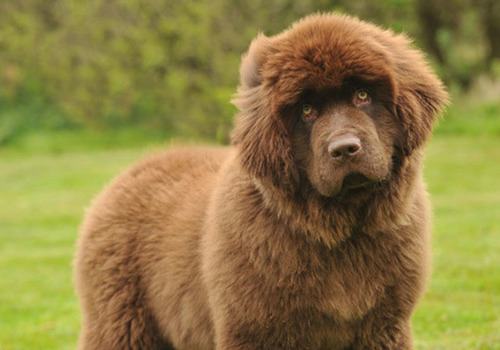The Newfoundland has a water-resistant double coat of black, brown, gray or Landseer (white with black markings). Using a steel comb and wire slicker brush, groom the coat at least a couple times a week to prevent mats and remove dead hair.
Newfies shed, and regular brushing will help reduce the amount of hair floating around your house. Twice a year, in spring and fall, they shed heavily, called “blowing coat.” Plan to spend additional time brushing to keep all the hair under control.
Newfies also drool, so get in the habit of carrying around a hand towel so you can wipe your dog’s mouth as needed, especially after he eats or drinks. Bathe the Newfoundland when he’s dirty.
The rest is basic care. As with all breeds, the nails shouldbe trimmed regularly, as overly long nails can cause discomfort and structural problems. Brush the teeth frequently with a vet-approved pet toothpaste for good overall health and fresh breath. Most importantly, keep this water-loving dog’s ears clean and dry to help prevent ear infections.
The Newfoundland is a multipurpose dog, at home on land and in water. As well as being a devoted companion, he is adept at draft work and has natural lifesaving abilities. Newfoundlands need at least a half-hour of moderateexercisedaily to stay healthy and happy. While they are definitely meant to live indoors with their human family, Newfs enjoy outdoor activities, especially swimming, and make great companions on long walks or hikes. Newfs enjoy pulling a cart, and some even participate in carting and drafting competitions.
Walks – brisk moderate walk 20 to 40 minutes.
Swimmingor water play – as much as you are willing to let him or she has.
Games – 20 minutes of frolicking games.
Play in the snow.
If you get a Newfoundland puppy from a breeder, they would give you a feeding schedule and it's important to stick to the same routine, feeding the same puppy food to avoid any tummy upsets. You can change a puppy's diet, but this needs to be done very gradually always making sure they don't develop any digestive upsets and if they do, it's best to put them back on their original diet and to discuss things with the vet before attempting to change it again remembering that puppies need to be given a very nutritious diet for their bones and joints to develop as they should.
Older dogs are not known to be fussy or finicky eaters, but this does not mean you can feed them a lower quality diet. It's best to feed a mature dog twice a day, once in the morning and then again in the evening, making sure it's good quality food that meets all their nutritional requirements.
Treatscan be an important aid in training, but giving too many can cause obesity. Learn about whichhuman foodsare safe for dogs, and which are not. Check with your vet if you have any concerns about your dog’s weight or diet.The breed can experiencebloat, a life-threatening condition where the stomach distends and twists. The causes of bloat aren’t fully understood, but experts agree that multiple, small meals per day and preventing vigorous exercise around mealtimes may help reduce the chances of it happening.
The average life span of the Newfoundland is about 10 years, similar to other giant breeds. This large purebred breed is no stranger to the disease. The Newfoundland is prone to Sub-Aortic Stenosis, hip dysplasia, elbow dysplasia, gastric torsion, and several common eye problems. As well, the Newfoundland can suffer from Von Willebrand’s Disease, an abnormal bleeding disorder, as well as epilepsy.
Good news – you’ll find Newfoundlands easy to train. You’ll get the best results by using positive reinforcement training methods. Because it is a sensitive breed, loud, raised voices are discouraging, so use repetition and positive rewards for the fast results.
Earlysocializationandpuppy training classesare recommended and help to ensure that the Newfoundland grows into a well-adjusted, well-mannered companion. A puppy who is going to be trained for water work should be carefully introduced to the water by the age of 4 months. Newfs are eager to please and generally easy to train. They are also affectionate and trusting; they respond well to gentle guidance but don’t respond well to harsh corrections or training methods.












